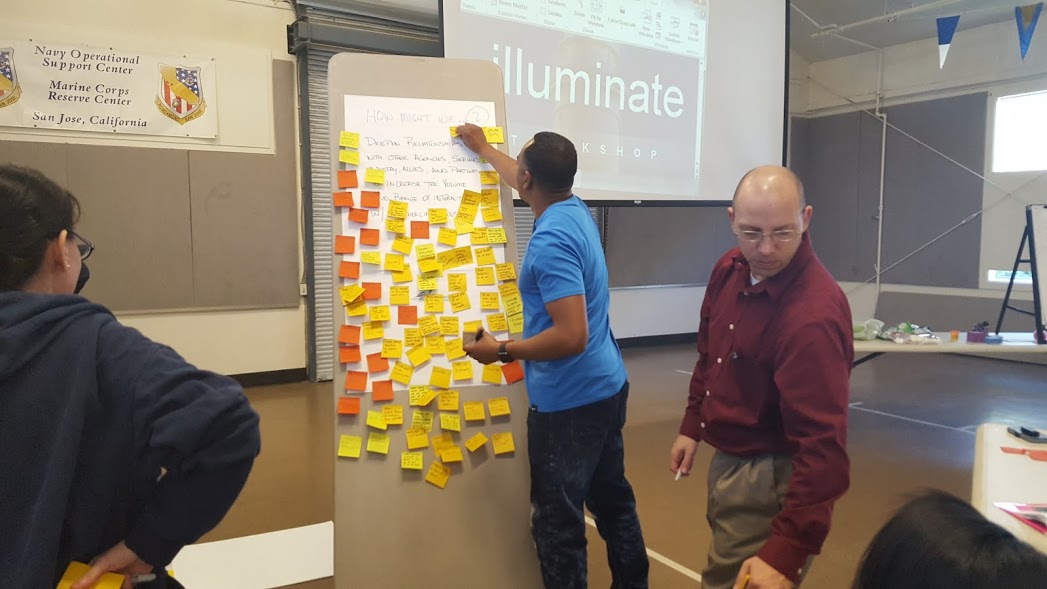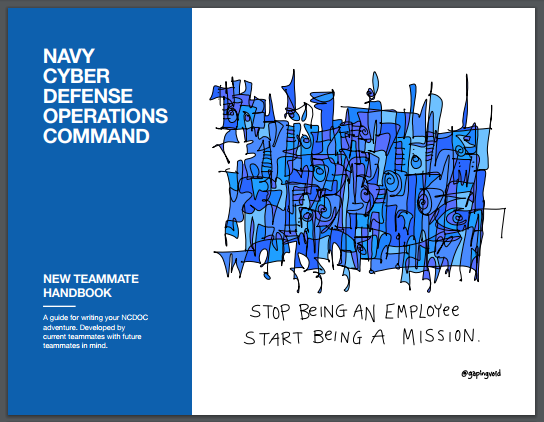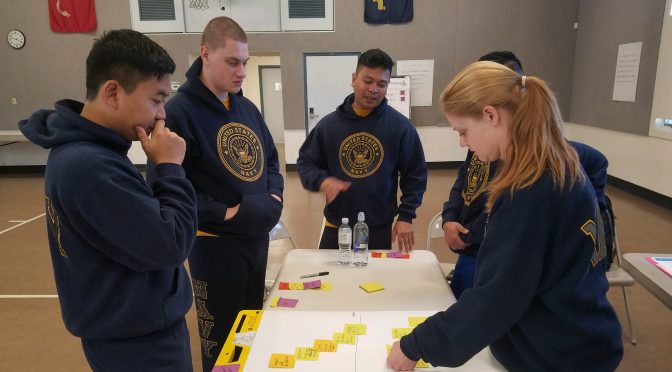In collaboration with U.S. Fleet Forces Command (USFFC) and Navy Cyber Defense Operations Command (NCDOC)
Introduction
The United States Navy has a proud tradition of mission accomplishment, regardless of the odds. From John Paul Jones taking the fight to the British shores aboard the Bonhomme Richard, to the hard-fought victories of the Pacific campaign, our naval service has been able to find the competitive advantage necessary to win. We have been fortunate that great people throughout our history have risen to the call when necessary. This long and storied list contains names such as Decatur, Preble, Farragut, Morton, Ellis, Puller, Hopper, and Halsey. The right person, with the right answer, at the right time— almost as if fate was on our side.
These larger-than-life figures make for compelling stories, but what if they were never born? What if these legends were not in the right place at the right time to save the day? What if the Navy fostered an environment wherein the creative problem solving, critical thought, and extreme ownership that called these legends to action were core competencies across the force? Imagine a force that spends less time prescribing exactly what to do and instead harnesses the power of the collective, a force where our competitive advantage is not simply people, but rather capable, empowered, and passionate teammates. We should develop teammates truly capable of leading us into the future because we are too comfortable reacting to the present.
To truly realize our potential, we must deliberately build upon our strong history and shape the ongoing cultural change across the force. We must make creative problem solving, critical thinking, and collective ownership core competencies, and go out of our way to enable teammates who reflect these traits. Our training pipeline and personnel system should reinforce those tenets. In the absence of that, or rather in parallel, we must focus on shaping culture at the unit level. This entails the creation of connective tissue across many efforts that seek the same outcomes to ensure scalability while creating new norms and delivering outcomes we have yet to imagine.
This article seeks to shine a light on the unnecessary level of risk aversion and bureaucracy in our organization, describe the fundamental principles behind design thinking and deckplate innovation, and share revealing examples of these principles in action at U.S. Fleet Forces Command (USFFC) and Navy Cyber Defense Operations Command (NCDOC).
A Learning Navy
In the Design for Maintaining Maritime Superiority, the Chief of Naval Operations lays out numerous lines of effort as a vision and strategy for the Navy’s future. The green line of effort, which challenges the Navy to “apply the best concepts, techniques and technologies to accelerate learning as individuals, teams and organizations,” is being realized in an emerging grassroots movement which has taken the challenge to “set aspirational goals” and use a combination of critical thinking, lessons from history, and methods of human-centered design to encourage creativity and innovation to create advantage.
A sustainable competitive advantage is difficult to identify, and often results from an interwoven mass of tangible and intangible factors. Tangible resources are easy to identify and range from financial capital to physical assets like airplanes and ships. Intangible resources, while more difficult to quantify, may be the most valuable assets that an organization possesses. Human resources provide long-term exploitable skills, productive effort, and tacit knowledge that is difficult to replace and hard for competition to replicate. Personal and organizational experience builds tacit knowledge, and can be described as the collective know-how of a group. Organizations often struggle to quantify or pass on this knowledge through verbal or written communication.
In order to prevent stagnation, the Navy must become a learning organization. A learning organization continuously transforms itself by properly unleashing its people’s tacit knowledge. Throughout the rich history of the Navy, innovation and creativity have often ebbed and flowed. As Peter Senge points out in his book The Fifth Discipline, many successful learning organizations share a common vision, willingly challenge their own mental models, and encourage their people to seek personal mastery and engage in team learning. The results are the Googles, Facebooks, Ubers, and Warby Parkers of the world. This is not to say the Navy should model itself in the image of Facebook or Uber. Clearly the business model of fighting and winning our nation’s wars differs from that of social networking or crowdsourcing vehicular transportation. But just as many different corporations with different goals and models have embraced rapid learning to achieve maximum possible performance, so too can the Navy, and the first step in becoming a learning organization is admitting that you are not one.
Though many senior leaders may disagree, our Navy, as a whole, is not a true learning organization–at least not yet. Everyone needs to grow comfortable with a continuous departure from the status quo as the start of a new way of thinking. Through the combination of these ideas, an organization can leverage the knowledge and abilities across the spectrum of its constituents. The core competencies of creative problem solving, critical thinking, and collective ownership will help us break this mold. Our current system fails to assess, develop, or value these competencies. But unbeknownst to many, a deckplate revolution has commenced.
A Revolution in Thought and Action
This revolution continues to bring smart creatives from across the Navy together to create a movement. They focus on reimagining our culture as one founded on the aforementioned core competencies. This is where design thinking comes into play. Much contemporary writing focused on change references design thinking, but what is it exactly? Is it a perceived silver bullet from industry that the military is attempting to latch on to? A fleeting “buzzword” quickly forgotten? Hopefully not.
Design thinking is about embracing the combined knowledge within an organization for maximum possible performance. Creating solutions can be difficult, especially if you have not effectively defined the problem. Design thinking provides a process to focus efforts and achieve results. Though many techniques and tools differ, design thinking is rooted in four major elements: define the problem, divergent thinking, convergent thinking, and refine/execute.

Defining the problem is very easy to gloss over, but it can be the most important step. Are you solving the right problem or simply a symptom of a higher systemic impediment in your organization? Design thinking encourages approaching the problem from different perspectives to ensure you are still solving the correct or complete problem. Seek to ask why until you have worked past the easy answers and get to the truly hard question. Don’t just look for the simplest and most obvious solution, but seek as many different solutions as possible. Divergent thinking facilitates this concept, especially with many people working together. The goal is to diverge into as many ideas as possible, where the most opportunities appear when you are not constrained by finding the “best” solution. Think quantity over quality; many people can’t arrive at the right answer without fully embracing their comfort in the group or without pulling ideas from previous ‘bad’ examples.
After generating as many opportunities as possible, design thinking uses tools to group, merge, and then pare down the solutions until, through synthesis, converge on the best functional results. To higher leadership, this can be considered a catch-all in removing the ‘Good Idea Fairies’ from the group and allowing the best solution to bubble to the surface. This solution will be free of emotion and carries with it a vector towards positive change.
After arriving at a solution, seek refinement and development through basic prototyping. Design thinking provides tools to prototype solutions that seek to test the foundations of the idea rather than building a working physical product. This enables testing and further development with minimum resources. For higher levels of leadership, this may work towards an entire command or unit. When implemented from the ground-up – individuals, workcenters, divisions, and departments – this equates improvement across the spectrum.
After the solution has been refined, execute. Ideas without execution are meaningless. It takes action to bring an idea to fruition, and without that action, design thinking is truly just the latest “buzzword” spoken in an echo chamber.
Leadership’s Role
Upon the conclusion of the event, the collaboration and support of the participant’s leadership is necessary to promote the success of these young leaders by providing them with time, trust, and top cover. These core aspects drive the successful engagement of our young Sailors and Marines, and inspire every ounce of our commitment and progress. Without them, we don’t have the perspective to see beyond our silo of thought. The relationship between leadership’s time, trust, and top cover and rank and file empowerment defines the success or failure in the leader-led relationship. All of the time and trust in the world does nothing if you don’t have someone blocking for you along the way. Conversely, there is no top cover that someone can give you that would produce results without the adequate time and trust that goes along with it.
The illuminate Th!nkshop at Fleet Forces

The illuminate initiative at Fleet Forces Command is one grassroots program bringing design thinking courses to Sailors and Marines. Turning the traditional paradigm of learning on its head, they encourage shrugging off bureaucracy, taking ownership, and focusing entirely on problem-solving and process improvement as opposed to passively receiving top-down innovation initiatives. Based in the concepts of design thinking, the Th!nkshops seek to identify solutions through a process of divergent and convergent thinking, coupled with the critical thought and positive mindset vital to the process itself.
Like many other organizations in this grassroots movement, illuminate champions the fact that the foundations, objectives, materials, and format are designed and taught by a small team of active duty Sailors and Marines. Led by a passionate group of individuals, the course has already made a difference across the Navy. These efforts have primed the pump of an ad-hoc network of like-minded Sailors and Marines that seek to collaborate and achieve results. With the right resources and an expanded inventory of design thinking and organizational learning methods at their disposal, this network could move from an ad-hoc group of facilitators to a connected group of command sponsored representatives that will achieve maximum performance across the Navy.
Refining The Process
Getting the Th!nkshop pilot off the ground would not have occurred without an incubation phase. Illuminate needed people to iterate and a laboratory to experiment in order to refine the course. Enter Navy Cyber Defense Operations Command (NCDOC). The Echelon IV command participated in numerous iteration sessions and helped develop the Th!nkshop curriculum. Throughout this process, NCDOC personnel received personal and professional development training and provided candid feedback to the illuminate facilitators. The USFFC Th!nkshop facilitators refined the course based on the feedback. This cycle of iteration, development, and growth continued for several months. As a result, NCDOC adopted and launched its own chapter of illuminate utilizing their own in-house facilitators, while USFFC simultaneously began to spread illuminate across the naval enterprise.
Since leaving NCDOC in December 2016, USFFC has impacted numerous commands. These include more than 40 commands at Seventh Fleet (C7F), Space and Naval Warfare Systems Command (SPAWAR), Southwest Regional Maintenance Center (SWRMC), and Naval Operations Support Center (NOSC) San Jose. They are scheduled to travel this summer to NOSC Dallas, East and West Coast Submarine Forces, SWRMC, and SPAWAR. They also conduct a series of Th!nkshops in Norfolk where they have trained Naval Expeditionary Combat Command (NECC), Fleet Readiness Center Mid-Atlantic (FRCMA), National Guard, Reserve Forces (RESFOR), and Naval Information Forces (NAVIFOR); summer plans include OPTEVFOR (Commander Operational Test & Evaluation Force), Transient Personnel Unit (TPU), Explosive Ordnance Disposal Mobile Unit (EODMU) 12, and Special Boat Team 20.
NCDOC’s support and assistance provided the fertile ground for the Th!nkshops to blossom from an amazing idea to a training mechanism directly impacting Sailors and Marines. Their partnership laid the foundations for illuminate to scale across the fleet.
The NCDOC Experience
The time, trust, and top cover of a trusted ally provided the fertile ground for the illuminate Th!nkshops to grow and develop. In its early phases, illuminate took root at Navy Cyber Defense Operations Command (NCDOC). But long before opening their makerspace for Th!nkshop incubation and refinement, NCDOC began a deliberate culture shaping journey. A journey as unique as their mission; one that continues to make them the Navy’s “Purple Cow,” to borrow a term from Seth Godin.
They don’t use a Command Assessment Team to assess climate, they have a Culture Club that shapes culture. They use a 360-degree hiring panel to select new civilian teammates, and conduct 360-degree feedback for all E-7 and above as well as supervisory civilians. They have shaped a culture that truly combines the power of the 21st century mindset with the best of our strong Navy tradition. The foundational experience among NCDOC Teammates is their tailored version of the illuminate Th!nkshop, which is integrated within their 100 Day Onboarding process. Over the last few months, the Th!nkshop alums have reinvented peer recognition, reimagined mentorship using the NFL draft as the model, developed a locator tool to navigate their building, crafted a New Teammate Handbook using Valve’s New Employee Handbook as inspiration, redesigned their next Command Climate Survey, and directly leveraged design thinking to reorient operational execution.
The most visible evidence of the significant culture shift at NCDOC is the aforementioned New Teammate Handbook. It not only serves as a vehicle to reinforce their ongoing commitment to culture-shaping initiatives, it also serves as an example of how the public sector must both lead and engage if they are to give Smart Creatives reason to join the team.
The formatting of the handbook is not what you would expect from a government organization and neither are the words contained within. Everything from the internally developed Waypoints that articulate shared behavior across the NCDOC team, to the “Allowed To” list that compels all teammates to be “Doers,” speaks to a team that truly values competence, collaboration, and character. And because words are hollow when not supported by action, one need only watch their Innovation Cross Functional Team coach “Idea
Champions” at all ranks through the process of making their ideas reality to see that the “Doer” philosophy runs deep across the team and produces results.”

NCDOC serves as a visible example that it’s not about the Th!nkshop itself; it’s about the culture it fosters and the operational outcomes that a culture of creative problem solving, critical thinking, and collective ownership generates. The NCDOC team interacts differently than any other within the Navy. Their spaces are different from any other within the Navy, and their approach to just about everything is different from any other within the Navy. It’s not about being different for the sake of being different, but rather about caring enough to question everything, to allow expertise to trump rank, and to prioritize long-term significance over short term success. NCDOC is a prime example of how a sustained commitment to facilitating Th!nkshops impacts thinking, doing, and mission accomplishment at the unit level. A Th!nkshop experience may leave you inspired to do more, but without the visible commitment to the tenets it teaches by leaders at every level, you will quickly be reminded of the short shelf-life of inspiration.
The Future
The work at USFF and NCDOC is not Navy-mandated, but simply the result of some forward-thinking minds within the Navy and Marine Corps, the desire to make a difference, and the opportunity to do so. Th!nkshops have inspired many, but we measure impact by our ability to sustain and scale the transformation ignited to date. Th!nkshops alone won’t generate the outcomes we need; command triads committed to culture shaping and helping each teammate realize their potential will. We offer our Th!nkshops as a vehicle to kickstart local initiatives, and welcome the opportunity to partner with units across the Navy. These partnerships grow and strengthen our network of leaders committed to creating an environment that affords us the opportunity to evolve into a true learning organization. This environment not only ensures great ideas are prevalent, but as our Chief of Naval Operations has made clear, allows us to turn those ideas into something real.
Contact us below for more information on how you can be a part of the Th!nkshop movement.
LCDR Owen Morrissey and LT John Hawley are currently assigned to USFFC in support of the CNO’s Design for Maintaining Maritime Superiority. They can be contacted at owen.morrissey@navy.mil for executive engagement and john.w.hawley@navy.mil for more information and to schedule an illuminate thinkshop. For more information on the NCDOC state of mind, contact Dr. Rebecca Siders at rsiders@ncdoc.navy.mil.
Featured Image: Sailors assigned to NOSC San Jose participate in a rapid ideation session during a reserve drill weekend. (Photo by LCDR Owen Morrissey)

